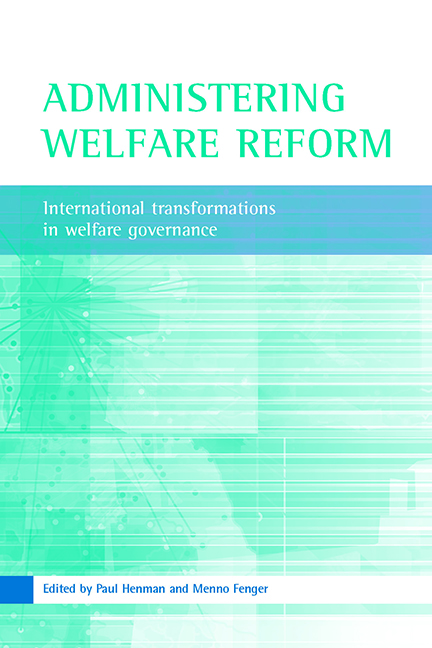Book contents
- Frontmatter
- Contents
- List of tables
- Preface
- Acknowledgements
- List of abbreviations
- Notes on contributors
- one Introduction: administering welfare reform
- two Welfare reform as governance reform: the prospects of a governmentality perspective
- Part One Participants: reforming the agents of welfare delivery
- Part Two Practices: the welfare governance of street-level practices
- Part Three Processes: the changing spaces of welfare governance
- Index
- Also available from The Policy Press
six - ‘Ending welfare as we know it’: welfare reform in the US
Published online by Cambridge University Press: 14 January 2022
- Frontmatter
- Contents
- List of tables
- Preface
- Acknowledgements
- List of abbreviations
- Notes on contributors
- one Introduction: administering welfare reform
- two Welfare reform as governance reform: the prospects of a governmentality perspective
- Part One Participants: reforming the agents of welfare delivery
- Part Two Practices: the welfare governance of street-level practices
- Part Three Processes: the changing spaces of welfare governance
- Index
- Also available from The Policy Press
Summary
When President Bill Clinton signed welfare reform into law in 1996, he fulfilled his campaign promise to ‘end welfare as we know it’. In the US, the term welfare most commonly refers to the public assistance programme for poor single mothers and their children. Although this chapter will focus on changes made to Temporary Assistance for Needy Families (TANF), the cash aid programme for poor single mothers and their children, significant changes have also been made or are being proposed for other welfare programmes, including the social security pension system, government health insurance programmes (Medicaid and Medicare) and unemployment insurance. This chapter will examine the effects of welfare reform on states, welfare delivery organisations and welfare recipients. Specifically, it will address whether giving states increased flexibility has improved their ability to respond to local conditions and needs. The chapter will also examine the new strategies adopted by welfare agencies to implement welfare-to-work programmes in addition to their responsibility to determine eligibility and control fraud, and whether these strategies created the desired results of increasing recipients’ participation in the paid labour force. Last, this chapter will consider the effects of welfare reform on recipients. It will specifically examine recipients’ ability to enter into the paid labour force and to stay off welfare after finding employment.
The US social security framework
In the US, the social security system gives monthly cash benefits to people over the age of 65 who paid into the system as well as to people with disabilities and to widows and their children. Unlike TANF, the benefits for social security are set by the federal government, not the states. Since its enactment, social security has significantly reduced poverty among older people. In fact, in 1999, the proportion of older people in poverty was 10.5%, a proportion lower than the population as a whole (Katz, 2001). Although social security used to be considered an ‘untouchable’ aid programme, President George W. Bush has made social security reform one of the priorities of his second term. Under his proposed changes, younger workers would be allowed to put some of their payroll taxes into Individual Savings Accounts instead of into the Social Security Trust Fund. It is unclear what the long-term results of Bush's plan will be. However, the transition costs to Bush's proposed system are estimated to add US$4 trillion by 2040 (Aaron, 2004).
- Type
- Chapter
- Information
- Administering Welfare ReformInternational Transformations in Welfare Governance, pp. 117 - 136Publisher: Bristol University PressPrint publication year: 2006



